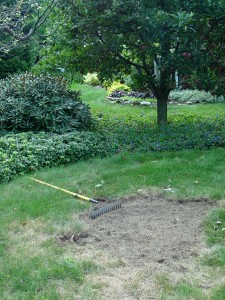Our so-called “low-maintenance” lawns
September 21st, 2010
I just got done breaking my back and blistering my hands this weekend trying to patch the dead spots in my lawn — again.

One of my dead lawn patches. Behind the destruction is an island bed of pachysandra and leadwort that I don't do anything to.
Every year it’s something. This year it was mainly heat burning out the perennial ryegrass. Other years it’s grubs or chinch bugs or drought or rust disease.
It seems like every fall, I’m raking off dead, matted grass, loosening soil, buying new seed, top-dressing with compost and then watering, watering, watering until it’s all up and growing.
That’s not even counting the ongoing fertilizing, raking leaves and mowing 25 times a year when the grass actually grows.
This is low maintenance?
When I look around my yard, I can find plenty of other areas (actually most of it) where I put in far less work and get way better results.
Only the vegetable garden rivals the lawn for work and expense. Most of the ornamental beds take a couple of spurts of effort per year (mainly mulching and a trim), and that’s about it.
Best of all are the beds of trees and shrubs that are underplanted with groundcover. I’ve got a border of Russian cypress (a low, spreading evergreen), dwarf boxwoods, ‘Biokovo’ hardy geraniums and liriope that takes maybe an hour or two of attention the whole year.
Another bed is a kidney-shaped island that ties together four trees and is filled mostly with pachysandra and leadwort groundcover, plus a few St. Johnswort ‘Albury Purple’ and rhododendron ‘Ken Janeck.’ I probably don’t even spend 2 hours total maintaining that bed all year.
Neither of these beds even need mulch because the groundcover makes a dense underplanting.
Both beds are bordered by lawn. When I add up the mowing time, twice-a-year fertilizing and blister-inducing patching each fall, it’s no contest which bed is better in terms of maintenance demand.
Sure, it takes more work and expense one time up front to convert the space, but once that’s done, the long-term advantage goes to the ornamental bed. The plantings are also more interesting to look at than one more sea of grass, and they’re far more friendly to wildlife.
I’m glad I don’t have any more lawn than I do. I’ve managed to reduce it to just the paths through my gardens.
No, that doesn’t mean I’m a lawn-hater. I like grass as well as any plant, but like any plant, it has its place and purpose. It makes great sense in high-traffic areas, like backyard soccer fields or entertaining areas.
But too often, we grow big lawns not because that’s our best choice but because it’s our default choice. Grass is quick and cheap to plant, so that’s what gets planted everywhere until the landowner gets motivated enough to replace it with something else. Usually, life gets in the way, and that switch-over never happens.
I say that since so many lawns are dead now anyway, this would be a great time to rethink whether you really want to keep doing the same thing or shift gears and convert to a better long-term planting.
If you’re thinking convert, here’s an article I wrote about a former Organic Gardening editor who scrapped much of her lawn in favor of plants: https://georgeweigel.net/favorite-past-garden-columns/shrinking-the-lawn.
If you’re thinking of patching the lawn one more time, here’s a piece on that: https://georgeweigel.net/favorite-past-garden-columns/lawns/fixing-a-dead-lawn.
I’ve gotta go rest my aching back now…







